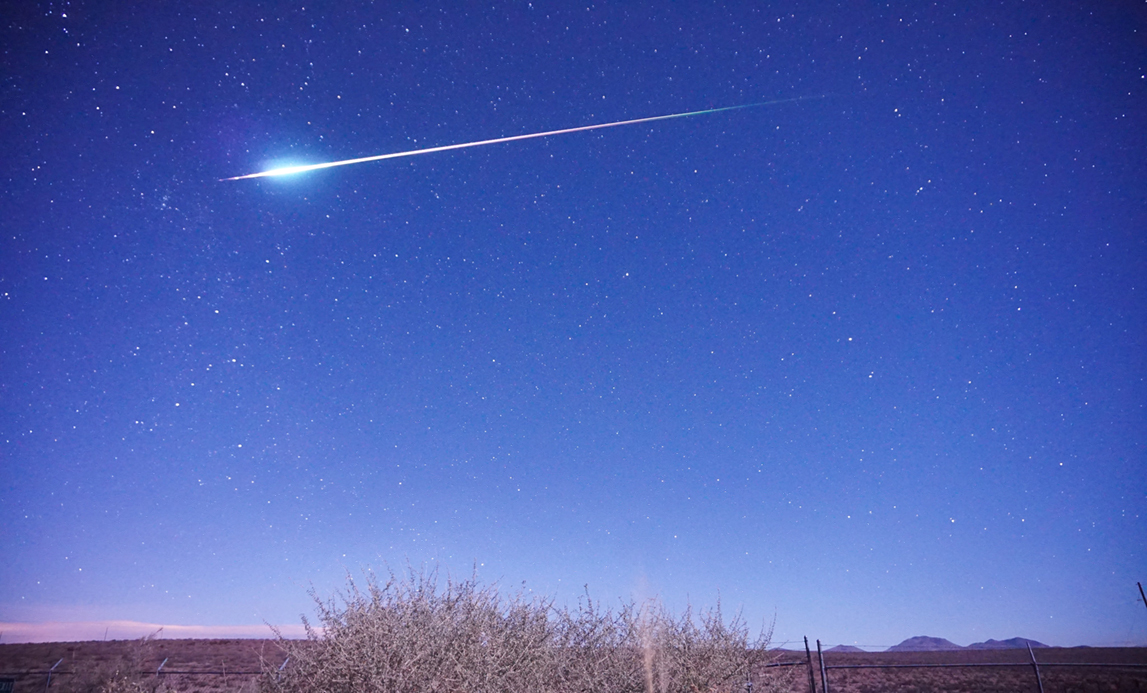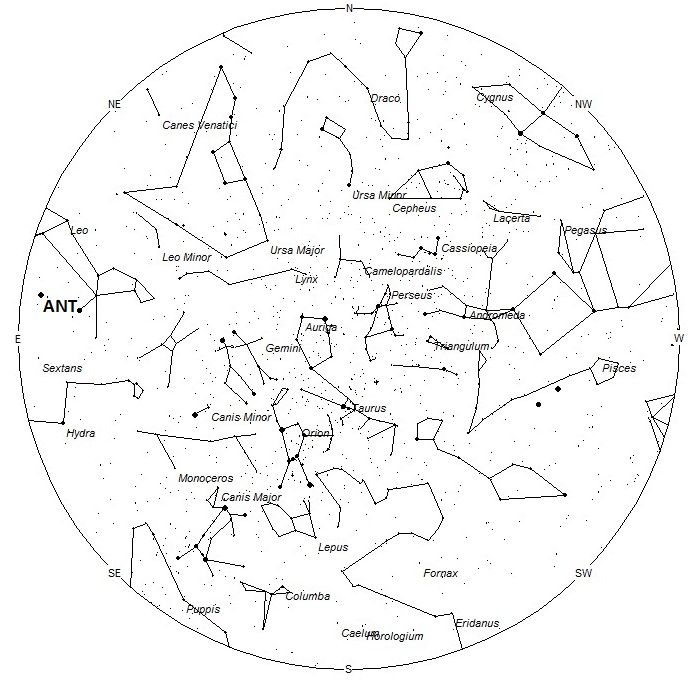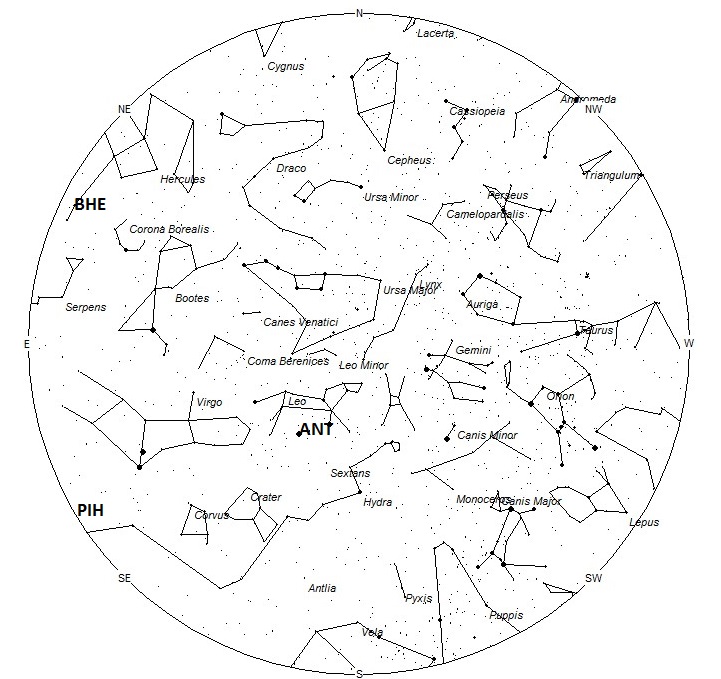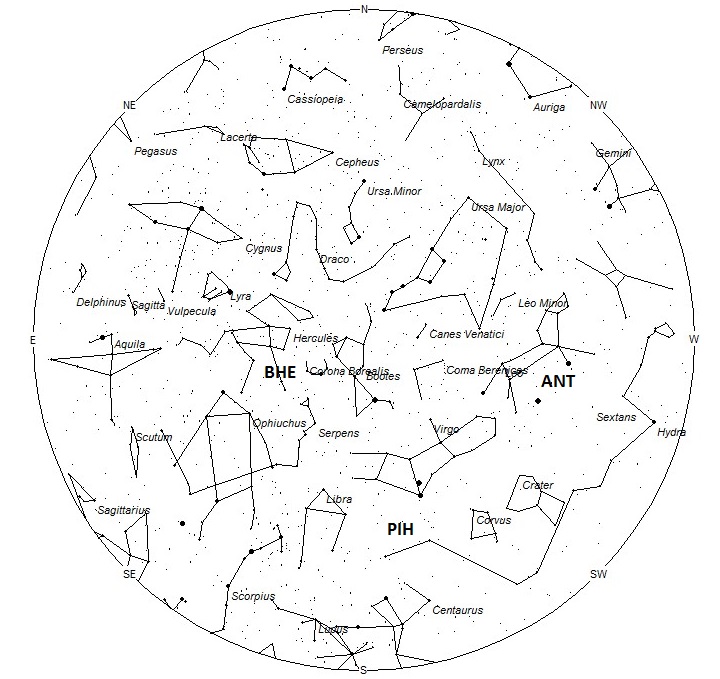
During this period the moon reaches its full phase on Saturday, February 11. This weekend the bright moon will make meteor observing extremely difficult as all but the brighter meteors will be obscured by the lunar glare. Toward the end of the period there will be several hours of dark skies available between the end of dusk and moonrise during the evening hours. The estimated total hourly meteor rates for evening observers this week is near 2 no matter your location. For morning observers the estimated total hourly rates should be near 5 as seen from mid-northern latitudes (45N) and 9 as seen from tropical southern locations (25S) Rates are reduced during this period due to intense moonlight. The actual rates will also depend on factors such as personal light and motion perception, local weather conditions, alertness and experience in watching meteor activity. Note that the hourly rates listed below are estimates as viewed from dark sky sites away from urban light sources. Observers viewing from urban areas will see less activity as only the brightest meteors will be visible from such locations.
The radiant (the area of the sky where meteors appear to shoot from) positions and rates listed below are exact for Saturday night/Sunday morning February 11/12. These positions do not change greatly day to day so the listed coordinates may be used during this entire period. Most star atlases (available at science stores and planetariums) will provide maps with grid lines of the celestial coordinates so that you may find out exactly where these positions are located in the sky. A planisphere or computer planetarium program is also useful in showing the sky at any time of night on any date of the year. Activity from each radiant is best seen when it is positioned highest in the sky, either due north or south along the meridian, depending on your latitude. It must be remembered that meteor activity is rarely seen at the radiant position. Rather they shoot outwards from the radiant so it is best to center your field of view so that the radiant lies at the edge and not the center. Viewing there will allow you to easily trace the path of each meteor back to the radiant (if it is a shower member) or in another direction if it is a sporadic. Meteor activity is not seen from radiants that are located below the horizon. The positions below are listed in a west to east manner in order of right ascension (celestial longitude). The positions listed first are located further west therefore are accessible earlier in the night while those listed further down the list rise later in the night.
These sources of meteoric activity are expected to be active this week.
Details on each source will continue next week when viewing conditions are more favorable.
| SHOWER | DATE OF MAXIMUM ACTIVITY | CELESTIAL POSITION | ENTRY VELOCITY | CULMINATION | HOURLY RATE | CLASS |
| RA (RA in Deg.) DEC | Km/Sec | Local Standard Time | North-South | |||
| Anthelion (ANT) | – | 10:24 (156) +10 | 30 | 01:00 | 1 -1 | II |
| pi Hydrids (PIH) | Feb 06 | 13:46 (206) -20 | 55 | 04:00 | <1 – <1 | IV |
| alpha Centaurids (ACE) | Feb 08 | 14:20 (215) -60 | 56 | 05:00 | <1 – 1 | II |
| beta Herculids (BHE) | Feb 14 | 16:24 (246) +25 | 53 | 07:00 | <1 – <1 | II |
 American Meteor Society
American Meteor Society



I think I saw the beta Herculids this morning. I was walking my dogs just before sunrise, approximately 6:20 am, pst, in San Francisco. I thought it was a airplane coming through the clouds but no clouds were in the sky. It was one of the most beautiful sights I have ever seen. It fizzled out just under the moon.
So it was actually a navy middle test over the Pacific Ocean. Not a meteor, but it was still a sight in the sky.
Ugh, sorry–Navy missile test.
I SAW A HUGE FIREBALL BETWEEN THE HOURS OF 9:00PM- 9:30PM YESTERDAY EVENING 2/13/2017 IN SANDOWN NH…BEAUTIFUL GREEN GLOW WITH SOME BLUE ON THE TAIL.
My husband called me outside this morning at 6:20 am . We saw what looked like a huge meteor with a large wide tail in the southwestern sky in Turlock CA
It looked like the large comet haleys back in the days but moved quickly
Meteor sighted 2/18/17 at 1152pm, Harleysville, Pa, immediately west of 113/63 near parallel to 63 and extremely low in the sky. Seemed to terminate well? before Snyder Rd.
At approximately 10:30pm pst I witnessed a large blue “ball of light” fall from the sky for about 2 seconds then disappear. I’ve been a pretty avid meteor watcher over the last few years and have never witnessed anything even close to this. Any ideas on what it could have been?
Chelsea and All,
This was a fireball, which is a meteor that is larger and brighter than normal. We have several other reports of this fireball. You can see a map of the locations of the other eyewitnesses at: http://www.amsmeteors.org/members/imo_view/event/2017/672
I’m located in Scott, LA which is outskirts of Lafayette and last night I was walking in the yard and I noticed a pretty large and intense orange object…for a split second I thought it was a plane but it blazed past above me and itwent on for a good ways leaving a beautiful beam before it ended in the turquoise flame. Not long after a very faint one in the distance I cannot find one report on it or anyone else who saw the same as I did. Can anyone help me out
Nikki and All,
We have one other report of a fireball that occurred at 10:45pm CST from a person located near Lafayette airport. You can look at their report of this fireball by visiting: http://www.amsmeteors.org/members/imo_view/event/2017/671
Robert Lunsford